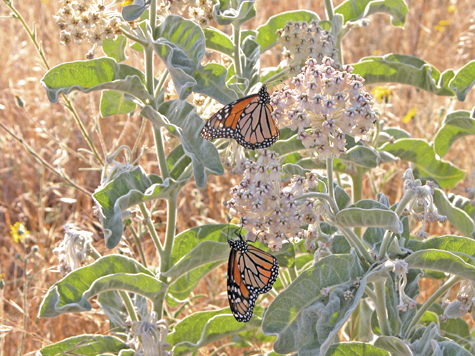
In late March, the monarch butterflies hibernating all winter in Mexico, Southern California and the Central Coast begin to migrate north.
In order to complete this treacherous migration and complete their life cycle, the monarch butterflies must locate milkweed to feed on and lay their eggs. In my observations, the monarchs seem to go back to the same areas of milkweed to lay their eggs each year–which is phenomenal because the generation laying this year’s eggs is four or five times removed from the monarchs that were here last year.
In our area of Figueroa Mountain, the Indian Milkweed on the mountain doesn’t develop until June, July and August, so we don’t see a lot of monarchs until they’re on the southern leg of their journey.
For tell-tale signs of the plump yellow and black monarch caterpillar, look for tiny dark green droppings (like fresh mice droppings) on the leaves and big holes where the caterpillar is eating; look to the underside of the leaves for the caterpillar and chrysalis.
From the time the egg is laid, it takes 2 weeks before you can see the caterpillar. When it’s ready, the voracious caterpillar stops eating and attaches itself, head down, to the bottom of a milkweed leaf, forming a chrysalis with a tiny gold dot near the top.
The chrysalis is the same green color as the milkweed (which can make it hard to spot), but with gentle exploration you’ll find one in no time.
When the butterfly is ready to emerge, the chrysalis changes from green to transparent, taking eight to ten days to complete. After it emerges, the butterfly pumps up its wings, dries off and takes to the sky to continue its parent’s journey into the unknown.
Milkweed grows all over Figueroa Mountain but an excellent place to find Indian Milkweed with monarchs and caterpillars is near the Davy Brown trail parking area and out on the Catway and Zaca Roads.
I hope you and your family will enjoy observing the monarch in all its fascinating stages.
In late March, the monarch butterflies hibernating all winter in Mexico, Southern California and the Central Coast begin to migrate north.
In order to complete this treacherous migration and complete their life cycle, the monarch butterflies must locate milkweed to feed on and lay their eggs. In my observations, the monarchs seem to go back to the same areas of milkweed to lay their eggs each year–which is phenomenal because the generation laying this year’s eggs is four or five times removed from the monarchs that were here last year.
In our area of Figueroa Mountain, the Indian Milkweed on the mountain doesn’t develop until June, July and August, so we don’t see a lot of monarchs until they’re on the southern leg of their journey.
For tell-tale signs of the plump yellow and black monarch caterpillar, look for tiny dark green droppings (like fresh mice droppings) on the leaves and big holes where the caterpillar is eating; look to the underside of the leaves for the caterpillar and chrysalis.
From the time the egg is laid, it takes 2 weeks before you can see the caterpillar. When it’s ready, the voracious caterpillar stops eating and attaches itself, head down, to the bottom of a milkweed leaf, forming a chrysalis with a tiny gold dot near the top.
The chrysalis is the same green color as the milkweed (which can make it hard to spot), but with gentle exploration you’ll find one in no time.
When the butterfly is ready to emerge, the chrysalis changes from green to transparent, taking eight to ten days to complete. After it emerges, the butterfly pumps up its wings, dries off and takes to the sky to continue its parent’s journey into the unknown.
Milkweed grows all over Figueroa Mountain but an excellent place to find Indian Milkweed with monarchs and caterpillars is near the Davy Brown trail parking area and out on the Catway and Zaca Roads.
I hope you and your family will enjoy observing the monarch in all its fascinating stages.










Hello it’s me, I am also visiting this website on a regular basis,
this site is genuinely fastidious and the viewers are actually sharing pleasant
thoughts.
Here is my site: vpn coupon code 2024
Quality articles is the crucial to interest the visitors to go to see the web site, that’s what this website is providing.
Check out my web blog vpn code 2024